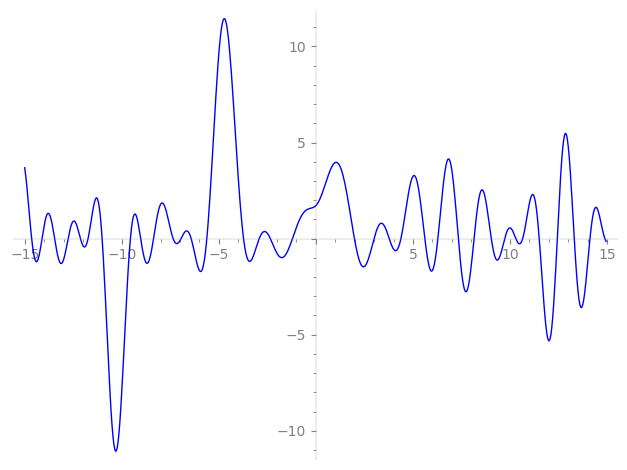| L(s) = 1 | + (0.863 − 1.69i)3-s + (0.951 + 0.309i)4-s + (−0.891 + 0.453i)7-s + (−1.53 − 2.11i)9-s + (0.809 − 0.587i)11-s + (1.34 − 1.34i)12-s + (−0.0966 + 0.610i)13-s + (0.809 + 0.587i)16-s + (−0.253 − 1.59i)17-s + 1.90i·21-s + (−3.03 + 0.481i)27-s + (−0.987 + 0.156i)28-s + (−0.363 + 1.11i)29-s + (−0.297 − 1.87i)33-s + (−0.809 − 2.48i)36-s + ⋯ |
| L(s) = 1 | + (0.863 − 1.69i)3-s + (0.951 + 0.309i)4-s + (−0.891 + 0.453i)7-s + (−1.53 − 2.11i)9-s + (0.809 − 0.587i)11-s + (1.34 − 1.34i)12-s + (−0.0966 + 0.610i)13-s + (0.809 + 0.587i)16-s + (−0.253 − 1.59i)17-s + 1.90i·21-s + (−3.03 + 0.481i)27-s + (−0.987 + 0.156i)28-s + (−0.363 + 1.11i)29-s + (−0.297 − 1.87i)33-s + (−0.809 − 2.48i)36-s + ⋯ |
\[\begin{aligned}\Lambda(s)=\mathstrut & 1925 ^{s/2} \, \Gamma_{\C}(s) \, L(s)\cr =\mathstrut & (-0.0128 + 0.999i)\, \overline{\Lambda}(1-s) \end{aligned}\]
\[\begin{aligned}\Lambda(s)=\mathstrut & 1925 ^{s/2} \, \Gamma_{\C}(s) \, L(s)\cr =\mathstrut & (-0.0128 + 0.999i)\, \overline{\Lambda}(1-s) \end{aligned}\]
Particular Values
| \(L(\frac{1}{2})\) |
\(\approx\) |
\(1.719771661\) |
| \(L(\frac12)\) |
\(\approx\) |
\(1.719771661\) |
| \(L(1)\) |
|
not available |
| \(L(1)\) |
|
not available |
\(L(s) = \displaystyle \prod_{p} F_p(p^{-s})^{-1} \)
| $p$ | $F_p(T)$ |
|---|
| bad | 5 | \( 1 \) |
| 7 | \( 1 + (0.891 - 0.453i)T \) |
| 11 | \( 1 + (-0.809 + 0.587i)T \) |
| good | 2 | \( 1 + (-0.951 - 0.309i)T^{2} \) |
| 3 | \( 1 + (-0.863 + 1.69i)T + (-0.587 - 0.809i)T^{2} \) |
| 13 | \( 1 + (0.0966 - 0.610i)T + (-0.951 - 0.309i)T^{2} \) |
| 17 | \( 1 + (0.253 + 1.59i)T + (-0.951 + 0.309i)T^{2} \) |
| 19 | \( 1 + (0.809 - 0.587i)T^{2} \) |
| 23 | \( 1 - iT^{2} \) |
| 29 | \( 1 + (0.363 - 1.11i)T + (-0.809 - 0.587i)T^{2} \) |
| 31 | \( 1 + (-0.309 + 0.951i)T^{2} \) |
| 37 | \( 1 + (0.587 - 0.809i)T^{2} \) |
| 41 | \( 1 + (-0.809 + 0.587i)T^{2} \) |
| 43 | \( 1 + iT^{2} \) |
| 47 | \( 1 + (-1.04 - 0.533i)T + (0.587 + 0.809i)T^{2} \) |
| 53 | \( 1 + (-0.951 - 0.309i)T^{2} \) |
| 59 | \( 1 + (-0.809 - 0.587i)T^{2} \) |
| 61 | \( 1 + (0.309 + 0.951i)T^{2} \) |
| 67 | \( 1 + iT^{2} \) |
| 71 | \( 1 + (0.5 + 0.363i)T + (0.309 + 0.951i)T^{2} \) |
| 73 | \( 1 + (-0.734 - 1.44i)T + (-0.587 + 0.809i)T^{2} \) |
| 79 | \( 1 + (1.53 - 1.11i)T + (0.309 - 0.951i)T^{2} \) |
| 83 | \( 1 + (-0.610 + 0.0966i)T + (0.951 - 0.309i)T^{2} \) |
| 89 | \( 1 + T^{2} \) |
| 97 | \( 1 + (0.183 - 1.16i)T + (-0.951 - 0.309i)T^{2} \) |
| show more | |
| show less | |
\(L(s) = \displaystyle\prod_p \ \prod_{j=1}^{2} (1 - \alpha_{j,p}\, p^{-s})^{-1}\)
Imaginary part of the first few zeros on the critical line
−9.025228208868335447516625583222, −8.363448074192869900064087399351, −7.35246326555916851622555028996, −6.94536936455494400995844571750, −6.42576311410741793736479513687, −5.61832203421280956164168610217, −3.72704659912055508208102821827, −2.91893958113262357524410322942, −2.34727486058073110445552667004, −1.20715323174183806367241544884,
1.98342010386541193676685383632, 2.99532687784710970951164703561, 3.77731618361856910372072010553, 4.37877260366601211433009322469, 5.61204357121730732635222048266, 6.28194290463954634161192099309, 7.33848704080996248530053691954, 8.146842588036899193075211335404, 9.034907229914865757382412754551, 9.724563028064299728879807534534

